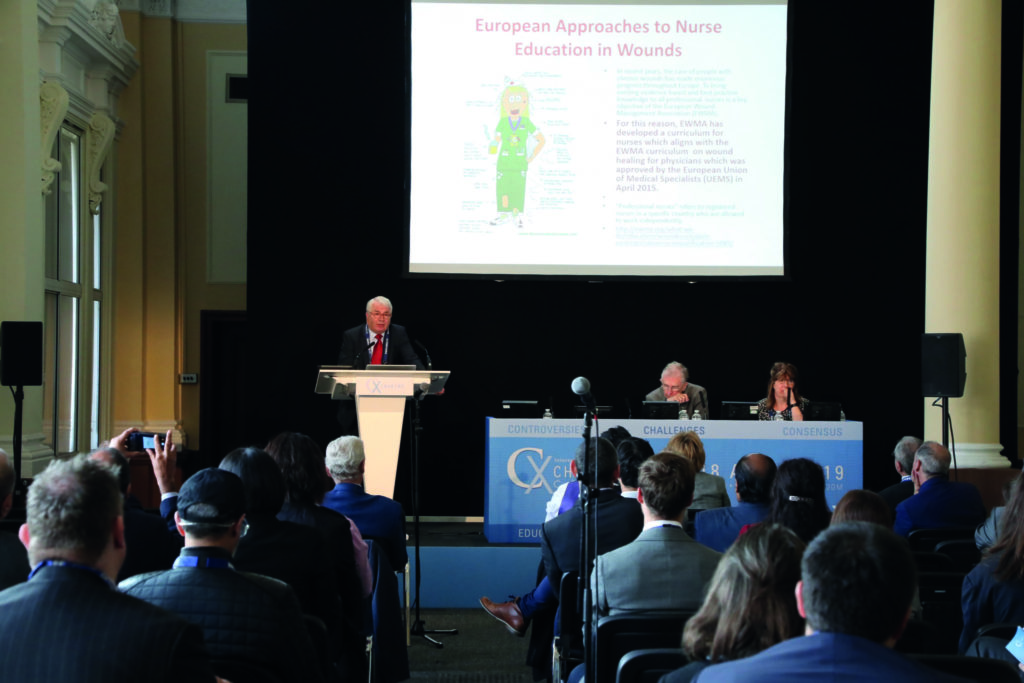
Keith Harding advocates for the increased involvement of medical staff in the treatment of patients with wound healing difficulties, as the number of chronic wounds seen in hospitals is on the rise. He argues that wounds “do not receive the attention they deserve”, and that patients are suffering as a result. Currently, he says, the majority of patients are seen by nurses, but additionally require input from specialists working across a wide range of disciplines. Harding believes that “there is no question that [vascular surgeons] have a significant amount to contribute to the management of patients with a range of wound problems”, and sets out his supporting arguments here.
It is increasingly recognised and accepted that wounds are both common and expensive in clinical practice. Recent publications have suggested that up to 10% of NHS [National Health Service] expenditure in the United Kingdom is directed towards treating patients with wound healing difficulties. Although the cost of the products used to affect wound healing is significant, the majority of the costs are driven by the inefficient, fragmented and haphazard way in which services are provided to patients with wounds.
In recent years, in most parts of the world, patients with wounds and wound healing difficulties are often seen as something that medical staff do not get involved in. This is because wounds are seen as a trivial problem that is delegated to nurses and other healthcare professionals, rather than something that merits the attention of medical staff. This has resulted in a greater focus on wound management and wound dressings rather than wound healing.
The wounds seen in clinical practice are caused by a wide diversity of clinical problems and conventionally divided into acute and chronic wounds. Chronic wounds are increasing in number because of changing demographics in western societies and it is recognised that although not all of these chronic wounds will heal, they do not receive the attention they deserve. In considering patients with leg ulceration, although most studies would suggest that by far most common underlying condition is venous disease, it should be recognised that there is a wide diversity of underlying diseases that can produce chronic ulceration of the leg. It is important, therefore, to recognise that a diagnosis has to be made as to that underlying condition, and once this has been undertaken an appropriate treatment regime should be offered to those patients. In patients with venous ulceration, there is increasing evidence that the role of surgery to correct the underlying venous disease may have a significant impact on healing.
Despite this, in most healthcare settings, these patients are seen by nurses, who spend a considerable amount of time working on the choice of dressings and bandages to treat these wounds.
Similarly, patients who develop pressure ulceration, which can be caused by a wide variety of medical conditions, may require the input of geriatricians, dermatologists, rehabilitation physicians, plastic surgeons, microbiologists, neurologists and spinal cord injury specialists. An increasingly important problem is that of diabetic foot disease— here, is it the role of the diabetologist, the vascular surgeon, orthopaedic surgeon, or microbiologist?
For vascular surgeons, there is no question that they have a significant amount to contribute to the management of patients with a range of wound problems, as common sense would suggest that no wound will heal if abnormalities in the vasculature are not addressed. In patients with arterial disease, there is no prospect for healing if there is insufficient blood supply or tissue oxygenation. In patients with venous disease, then surgical correction, where feasible, is an important aspect of assisting healing and preventing recurrent ulceration occurring. Similarly, there are many other wound situations where vascular intervention is a corner-stone of good care.
Unfortunately, even if the vascular supply and venous return from a wound is optimised, that still does not necessarily result in the healing of that patient’s wound. There are a number of issues associated with infection, offloading, oedema control and the impact of various drugs on wound healing that require the input of a range of clinical expertise.
The biggest driver of change in wound healing over recent years has been from industry, which has developed a number of new and novel approaches to affect wound healing. These approaches do, however, lack a robust evidence-base on which clinicians can make decisions to treat patients with proven effective interventions. It is important to appreciate that many patients require a range of interventions to affect closure of their wound problems that include, but are not exclusively focused on, the choice of dressings, bandages, mattresses and other devices. In addition to these interventions, there is a potential role of drugs, surgery and—if we follow the trends that are seen in the USA— biological approaches to healing which will be the next big advance in terms of treatment options that have failed for patients with wound healing difficulties.
Keith Harding is the professor of Wound Healing in the School of Medicine at Cardiff University, Cardiff, Wales, and works at the Skin Research Institute of Singapore. His clinical practice is exclusively focused on treating patients with complex wound healing problems.














Great information about wound care. Also describes the patient situation and reaction towards wound healing. It was interesting. Thank you!
Well-said! Thank you for sharing the significance of wound care. This information was really helpful & cleared all my major doubts.
Keep posting!